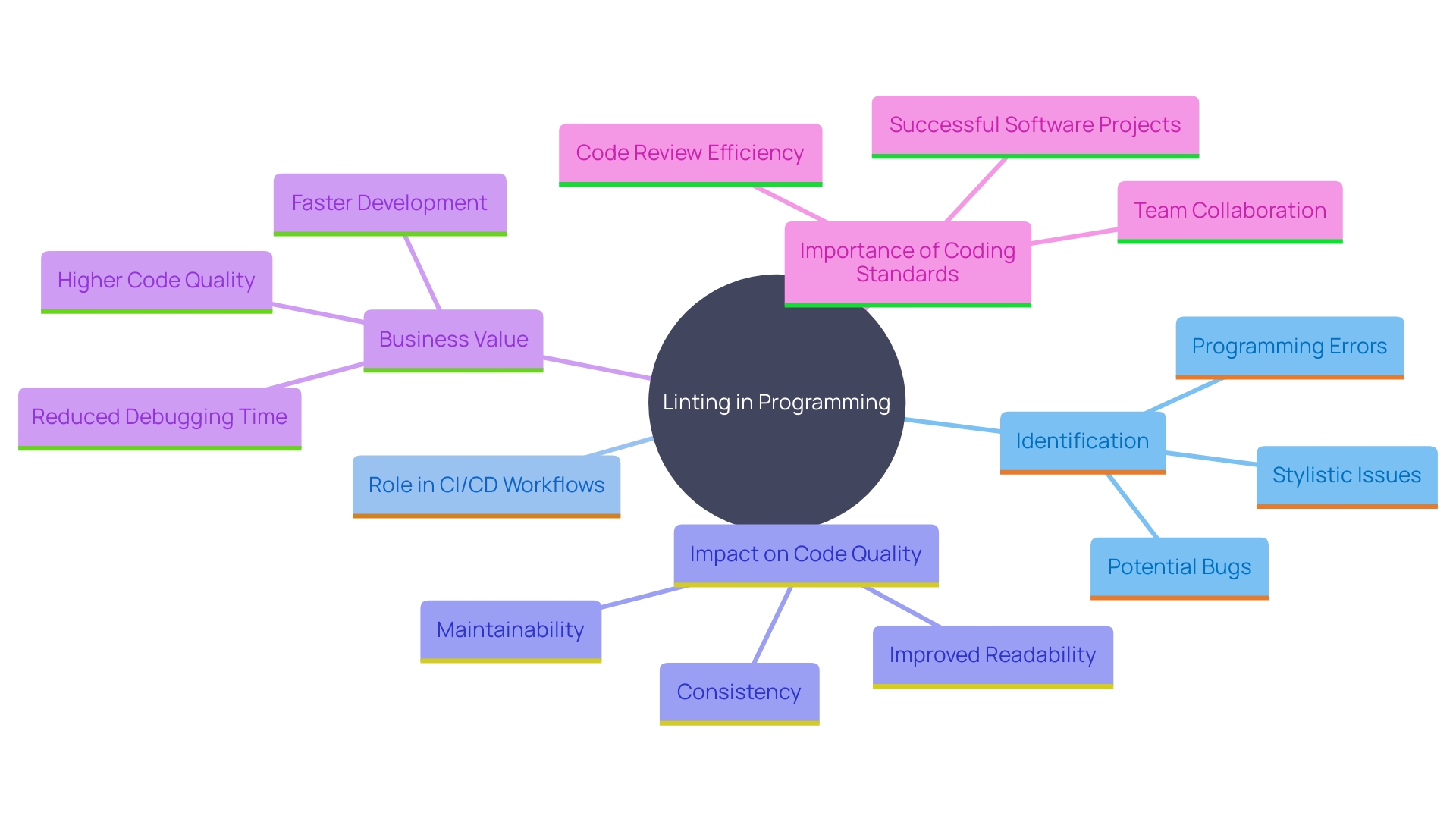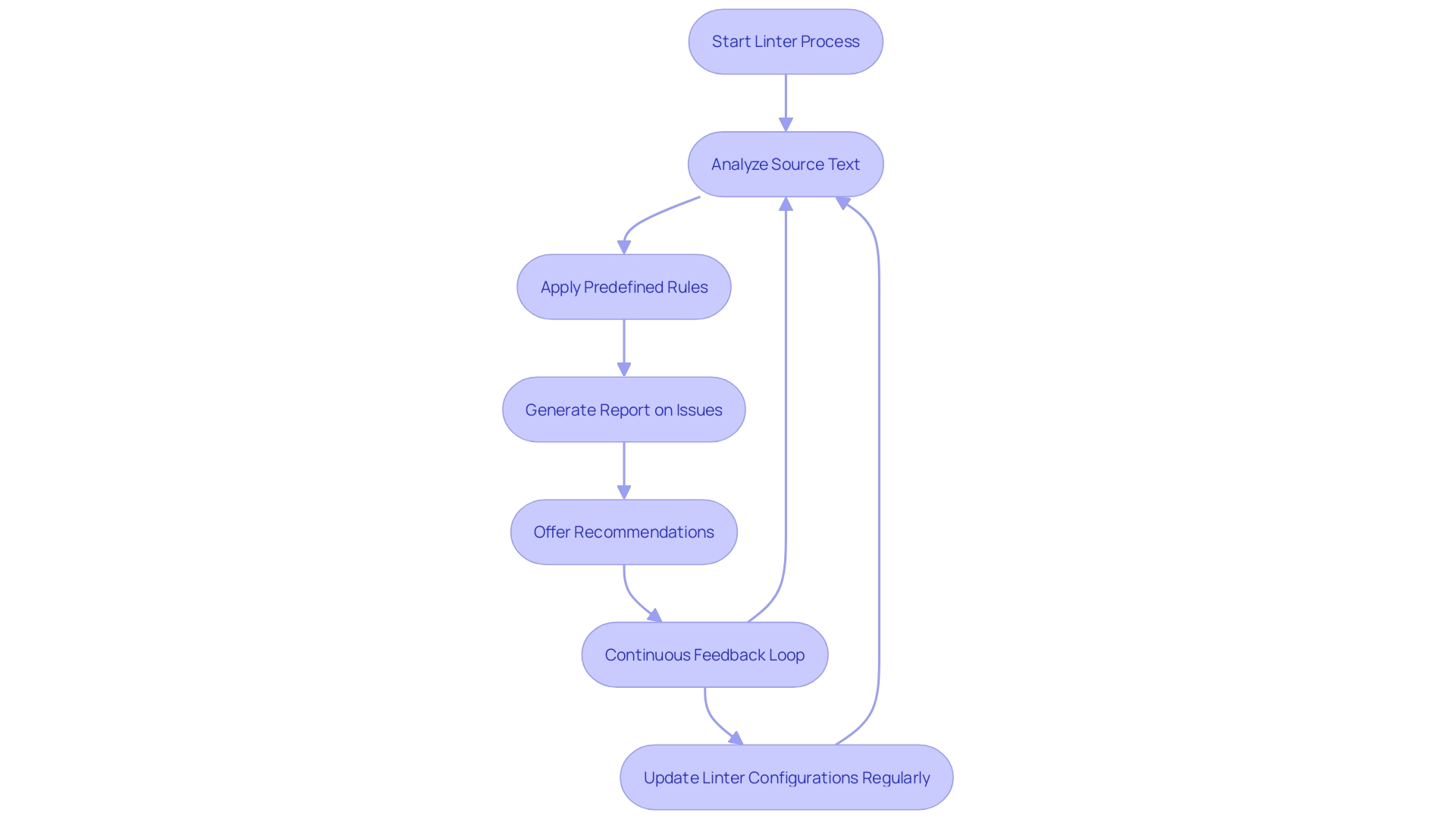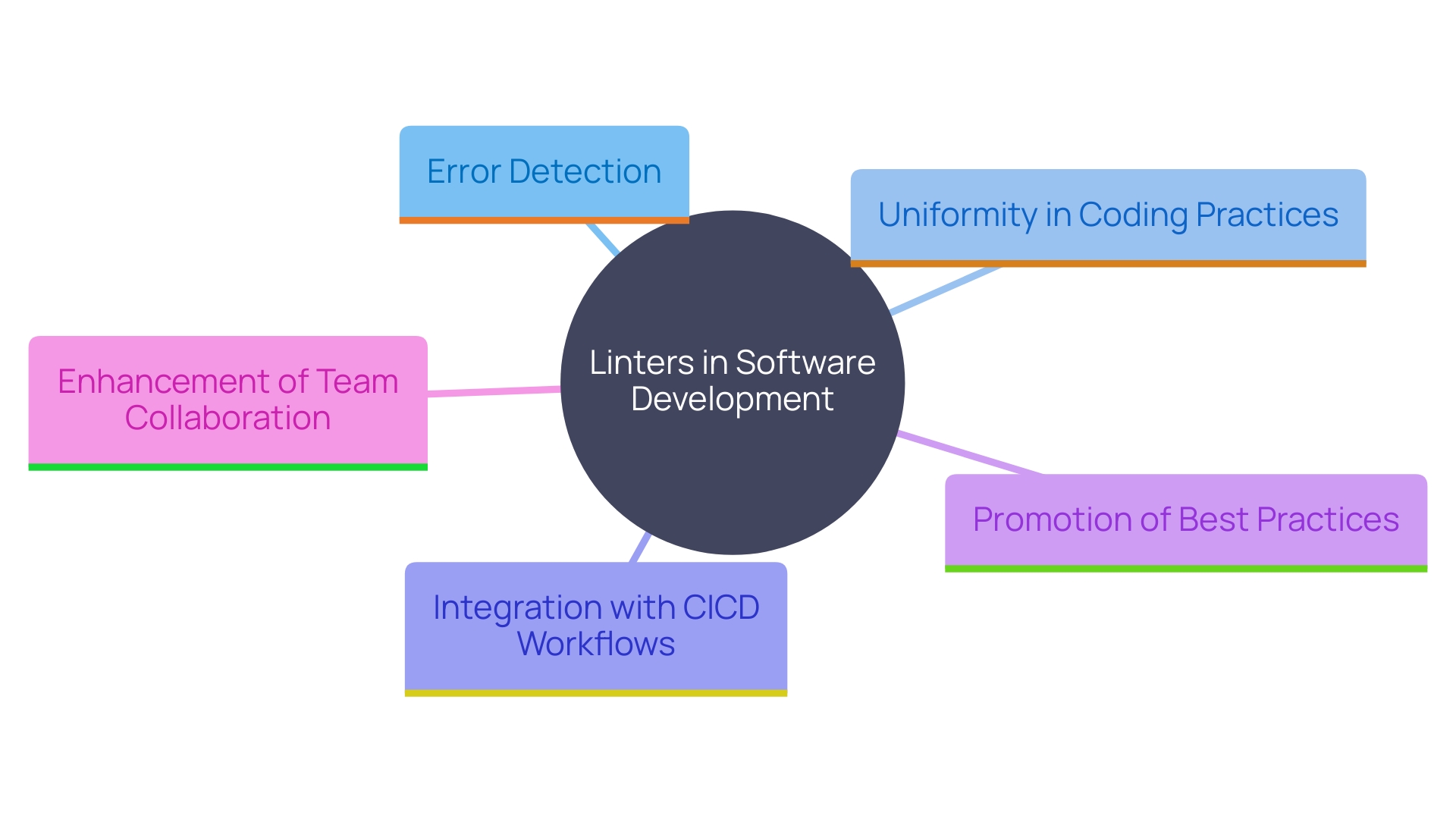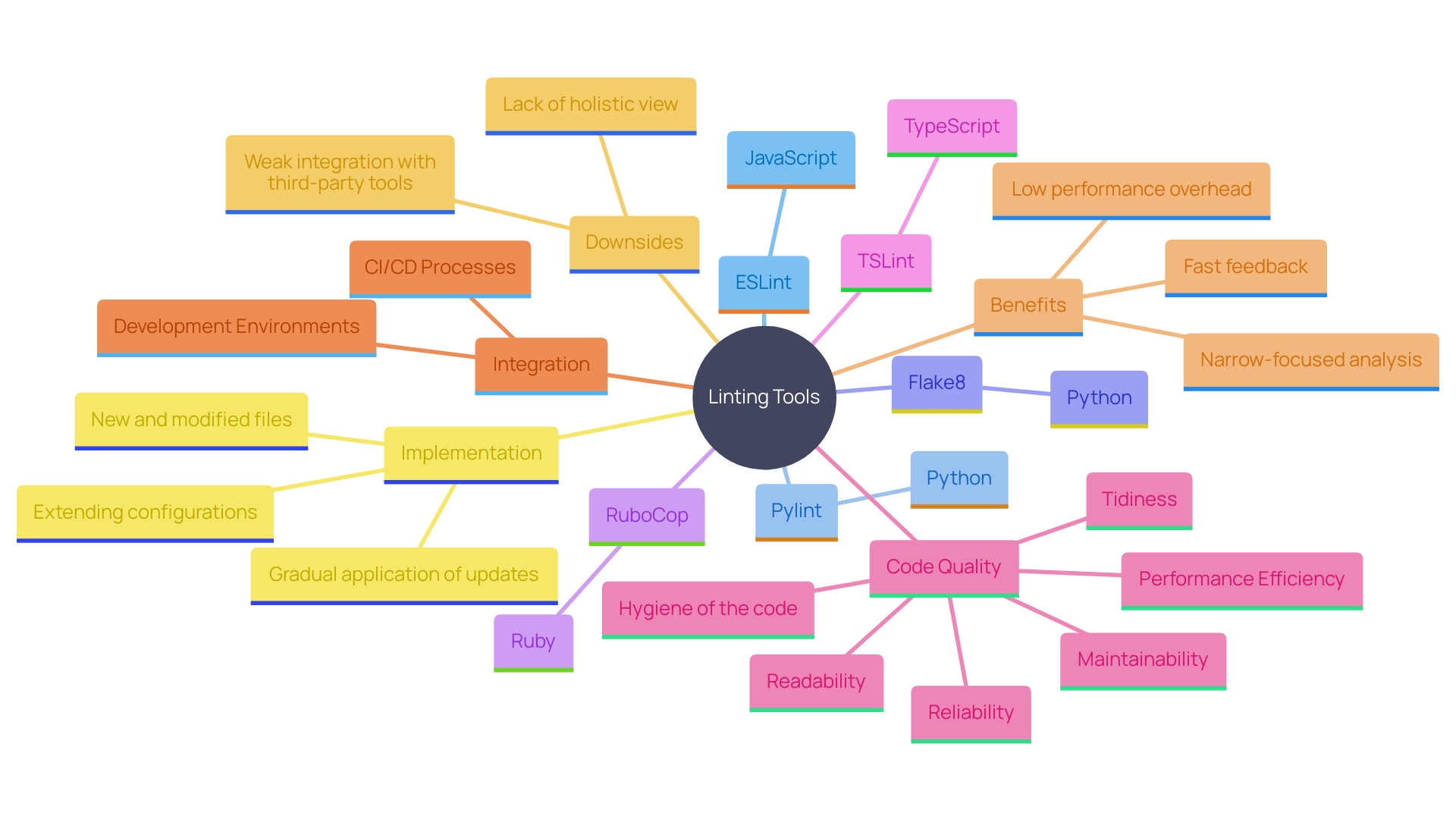Introduction
In the ever-evolving world of software development, maintaining high-quality code is paramount for achieving maximum efficiency and productivity. Code linting emerges as a powerful static analysis tool that not only identifies and flags programming errors but also enforces coding standards and best practices across a project. By integrating linters into the development workflow, developers can receive immediate feedback, ensuring that issues such as syntax errors, unused variables, and potential bugs are swiftly addressed.
This not only enhances code readability and maintainability but also significantly boosts overall project efficiency. Dive into the world of linters to discover how these tools can transform your coding practices, streamline team collaboration, and elevate your software projects to new heights.
What is Code Linting?
Linting serves as an indispensable static analysis process that identifies and flags programming errors, stylistic issues, and potential bugs in source material. Functioning as an automated review system, linters offer programmers with instant feedback on quality, ensuring that problems such as syntax mistakes, unused variables, and violations of coding standards are swiftly resolved. By examining scripts without running them, linting programs uphold a high standard of cleanliness, which is essential for clarity, upkeep, and performance effectiveness.
Linters can guide developers on everything from spacing between lines to restricting the usage of certain patterns. Incorporating these tools into your CI/CD workflow enables ongoing quality assurance, with builds failing if non-compliant software is detected. This standardizes best practices and opinions across teams, which is particularly beneficial for large projects with multiple contributors. As noted, "Good programming isn't just about making things work.". It's the foundation of successful software projects." Ensuring clean programming through linting is a step towards achieving this foundation.
Statistics reveal a non-linear relationship between programming quality and business value, underscoring the importance of maintaining high standards in development. For example, a codebase with a Code Health score of 9.0 is considered healthy but hasn't reached its full potential. By adhering to rigorous linting and programming standards, developers can enhance the readability and maintainability of their work, leading to more robust and efficient software solutions.

How Do Linters Work?
Linters function by analyzing source text and applying a comprehensive set of predefined rules or guidelines. These guidelines can be tailored to fulfill the particular requirements of a project or organization, ensuring that the programming follows the latest standards and best practices. When a linter examines the program, it produces a comprehensive report that emphasizes identified problems, frequently offering practical recommendations for resolving them. 'This process integrates seamlessly into the development workflow, enabling continuous feedback as programming is done, which is crucial to maintaining high quality and staying up-to-date with new development approaches.'.
Contrary to the common misconception that configuring a code analysis tool is a one-time task to be forgotten after initial setup, these tools and their rules evolve just like any other libraries. New configurations, rules, and modifications to current rule options arise, affecting the quality of the programming based on how and when the linter was set up. As highlighted in recent studies, advanced linters go beyond basic syntax checking to enforce specific coding style guidelines, detect potential bugs, and identify security vulnerabilities early in the development process. This proactive approach can significantly reduce the time spent on reviews and increase overall productivity.
For instance, at Google, the application of machine learning-suggested programming modifications has been reported to save hundreds of thousands of engineer hours annually. This feedback loop not only boosts productivity but also allows developers to focus on more creative and complex tasks. Therefore, regularly updating and fine-tuning linter configurations is essential for maintaining a high-quality codebase and leveraging the latest language features.

Benefits of Using Linters
Linters are essential instruments in the software development process, providing a variety of advantages that improve overall project efficiency and programming quality. By examining your programming and pointing out possible problems, analysis tools offer prompt responses on aspects ranging from line spacing to particular implementation styles. This proactive error detection helps prevent costly bugs from reaching production, significantly reducing debugging time.
Along with enhancing the quality of scripts, tools ensure uniformity throughout a repository, which is essential for teamwork. By standardizing programming practices, tools ensure that every element of the software adheres to the same rules, thereby simplifying maintenance and making it easier for new team members to understand and contribute to the project. For instance, incorporating code analysis tools into your Continuous Integration and Continuous Deployment (CICD) workflow can automatically reject non-compliant code, ensuring that only clean and well-structured code makes it into the build.
The benefits of lines extend beyond just error detection. They promote best practices and help developers learn and adhere to standardized coding conventions. This not only enhances the readability and maintainability of the program but also promotes knowledge sharing among team members. As one expert noted, “Good programming isn't just about making things work. It's the foundation of successful software projects.” Indeed, the application of linters in modern development environments underscores their role in fostering a robust and productive coding culture.

Common Linting Tools and Languages
Well-known linting applications are crucial for upholding quality and uniformity in different programming languages. For JavaScript, ESLint stands out as a robust tool, enabling programmers to enforce coding standards and catch errors early. Python programmers often turn to Pylint and Flake8, which provide extensive rule sets to ensure code adheres to best practices. Ruby programmers depend on RuboCop, while TypeScript projects gain substantial advantages from TSLint, enhancing type safety and error identification during development. These resources integrate seamlessly with IDEs and text editors, streamlining the linting process and enhancing developer productivity. By integrating these resources into your CI/CD process, you guarantee that every segment of software meets the highest standards, minimizing technical debt and promoting a cooperative atmosphere where team members can manage and enhance the software repository effectively. This approach not only enhances the reliability of programming but also acts as a learning resource for new contributors, directing them to produce superior programming from the beginning.

Best Practices for Using Linters
To maximize the effectiveness of code analyzers, developers should configure the tool according to project requirements and regularly update linting rules. Linters and their rules evolve just like any other libraries, and staying current ensures code quality remains high. Integrating linting into the continuous integration/continuous deployment (CI/CD) pipeline is another best practice. This integration enables code analyzers to catch errors and potential bugs early in the development process, reducing the time spent debugging later. For instance, ESLint uses a spread operator for extending configurations, making updates easier and safer. Another important aspect is fostering a culture of using linters among team members. This practice enhances compliance with coding standards and practices, resulting in the software being more robust and simpler to maintain. Linters also serve as educational tools for new contributors, guiding them to write better code and maintaining consistency across the codebase.
Conclusion
The importance of code linting in software development cannot be overstated. By serving as an automated code review tool, linters provide immediate feedback that helps identify and resolve programming errors, stylistic issues, and potential bugs before they escalate into more significant problems. This proactive approach not only enhances code quality but also significantly boosts overall project efficiency, allowing teams to maintain high standards of readability and maintainability across their codebases.
Integrating linters into the development workflow, particularly within CI/CD pipelines, standardizes best practices and fosters a culture of quality among team members. This ensures that all code adheres to the same guidelines, simplifying maintenance and enabling new contributors to quickly get up to speed. Moreover, the educational aspect of linters aids in promoting consistent coding conventions, which further strengthens the foundation of successful software projects.
Ultimately, leveraging linters is a strategic move that leads to more robust and efficient software solutions. By committing to regular updates and configurations, teams can ensure that their linting practices evolve alongside the ever-changing landscape of software development. Embracing these tools not only saves time and reduces technical debt but also cultivates a collaborative environment where developers can thrive and produce high-quality code.
Frequently Asked Questions
What is linting?
Linting is a static analysis process that identifies and flags programming errors, stylistic issues, and potential bugs in source code. It serves as an automated review system that provides programmers with instant feedback on code quality.
How do linters work?
Linters analyze source text against a comprehensive set of predefined rules or guidelines. They generate reports highlighting identified problems and often provide practical recommendations for resolving them.
Why is linting important?
Linting helps maintain high standards of programming quality, which is essential for clarity, upkeep, and performance effectiveness. It can prevent costly bugs from reaching production, significantly reducing debugging time and ensuring uniformity across a codebase.
How can linting be integrated into the development process?
Linters can be incorporated into the Continuous Integration/Continuous Deployment (CI/CD) workflow, ensuring that builds fail if non-compliant software is detected. This promotes ongoing quality assurance and standardizes best practices across teams.
What are some common linting tools?
JavaScript: ESLint; Python: Pylint, Flake8; Ruby: RuboCop; TypeScript: TSLint. These tools integrate with IDEs and text editors, enhancing the linting process and developer productivity.
How does linting enhance team collaboration?
Linting standardizes programming practices, making it easier for team members to understand and contribute to the project. This consistency simplifies maintenance and serves as an educational resource for new contributors.
What are the benefits of using linters?
Linters improve overall project efficiency, enhance code quality, promote best practices, and help developers learn and adhere to coding conventions. They also provide early detection of potential bugs and security vulnerabilities.
How often should linter configurations be updated?
Linter configurations should be regularly updated to reflect new rules and modifications, as they evolve similarly to other libraries. This ensures code quality remains high and leverages the latest language features.
Can linting tools impact business value?
Yes, research indicates a non-linear relationship between programming quality and business value. Maintaining high programming standards through linting can enhance the readability and maintainability of code, leading to more robust and efficient software solutions.
What role do linters play in improving productivity?
By providing continuous feedback and identifying issues early in the development process, linters reduce the time spent on code reviews and debugging. This allows developers to focus on more creative and complex tasks, ultimately boosting overall productivity.




